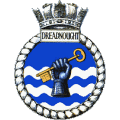You are viewing the archived version of the site.
Go to modelshipwrights.com for the current dynamic site!
Go to modelshipwrights.com for the current dynamic site!
1⁄700Build Up of the Tamiya 1:700 IJN Yamato
8
Comments
"New MSW crew-mate Anthony Kochevar (ajkochev) shares a fantastic build story of his IJN Yamato, in his first MSW submission!"
Edit. Note A special thanks to MSW Senior Editor Rui Matos (Skipper) for providing me with a huge effort in capturing and editing all images contained herein this article...thanks Skip!
It was the biggest battleship ever built. It was eventually sunk in April of 1945 during the “Ten-Go” suicide mission it was sent on. It was said at the time that when the Yamato sank she took four-hundred years of naval warfare with her, as battleships quickly become outmoded by aircraft carriers during and after the war.
Overview and Materials
The Tamiya 1:700 scale model of the Yamato was retooled in 1998. Tamiya really improved the fit and detail for this retooling and the result is a excellent kit. The Hull and main deck comes as one piece as well as the superstructure base, which makes working with and painting the model easier than some other battleships.
The aftermarket photoetch I chose were Tom’s Modelwork’s(TM) Yamato/ Musashi set, Gold Medal Model’s(GMM) Yamato/Musashi set and Lion Roar’s(LR) Yamato Main Gun detail set. I will periodically refer to these sets by their initials given in parenthesis. In addition, several sizes, shapes and sheets of Evergreen styrene will be used. Brass tubing, paper, various sizes of wire and stretched sprue(plastic tree from the kit melted with a candle and pulled apart) will be used for scratchbuilding other details.
The book Anatomy of a Battleship: The Battleship Yamato by Januzs Skulski is an excellent reference and a must for building this model. I made tread plate, out of fine mesh ribbon, paper spray adhesive and white glue. The process will be described later. You can buy photoetch tread plate but I choose to save a bit on cost. I also had several leftover Tom’s Modelworks IJN Aircraft Carrier photoetch sets that had inclined ladders. You may want to get this set as well as it has a good variety of parts for any IJN ship.
Tools and Glues As with most models various shapes and types of X-acto or hobby knifes will be used to shape and cut parts. Have several replacement blades on hand as they tend to dull quickly from use. A pin vise with various sizes of drills down to #80 will also be used.
A Dremel with cutting discs, sculpting and sanding bits is also a must for this project. Testors Model Sandpaper will be needed as well. The main glue will be liquid superglue(not the gel) purchased from a dollar store in small tubes. Testors clear parts cement and Tamiya Liquid Cement will also be used but only for certain applications. Tamiya Model Putty will be used to fill seams and shape areas. Don’t forget various emery boards, tweezers, paint brushes, masking tape, needlenose pliers, nippers and other basic modeler tools needed for the project.
Paint
I don’t mind using department store spray paint when possible as it is durable and saves money. ColorPlace brand Almond, White, Black and Fire Red purchased through Wal-mart will be used on the model. I decided to paint the hull using Tamiya IJN Kure Grey in a spray can. This paint sprays and airbrushes nicely. It does not brush well, so I mixed a matching color using Modelmaster Dark Gull Grey and Light Gull Grey.
I tested the spray and color mixing on scraps to get a feel for how to apply them. Several colors of the craft store acrylics and watercolor pencils will be used for the decks and weathering. Testors Glosscote and Dullcote in a bottle will be brushed on at various stages. Modelmaster Lusterless spray will be used to seal and finish the model.
Weathering and Other Details
Weathering the ship and adding cargo, ropes, tarps and other items are entirely optional however I think they provide a certain realistic and “lived in” look to the model. The materials used for this will be artists chalk in earth tones and several shades of grey from black to white. Also a mixture of 1/2 cup rubbing alcohol and 1/4 teaspoon India Ink will be used for detailing and weathering. Some craft store acrylics will also be used. The cargo and other details will be scratch built with styrene and stretched sprue.
Getting Started I read the kit instructions carefully several times to become familiar with how the kit is assembled. Likewise I read all photoetch instructions and marked which plastic parts will be replaced or augmented with the photoetch. I reviewed the book several times as well and started brainstorming how best to recreate certain parts or replace them with photoetch. I choose to use paper and styrene instead of photoetch for the hatches and doors. I carefully reviewed all the kit frets to get an understanding of where parts are located, and what will be modified and how.
With a basic plan of construction formed I proceeded to build and detail the hull first. The modifications will be listed in the following pages. In addition every part was removed when needed and the flash, edges and fret connection trimmed and sanded smooth. Parts were test fit when possible before gluing.
Edit. Note A special thanks to MSW Senior Editor Rui Matos (Skipper) for providing me with a huge effort in capturing and editing all images contained herein this article...thanks Skip!
Introduction
The Yamato was the flagship of the Imperial Japanese Navy(IJN) and was considered one of the most formidable ships of the time. The Yamato had two sister ships, the Musashi and the Shinano, the later being converted to an aircraft carrier after the battle of Midway. Yamato underwent several refits during its career with the 1944 version of the ship being the most impressive looking as it had the most anti-aircraft guns mounted on it during that time period.It was the biggest battleship ever built. It was eventually sunk in April of 1945 during the “Ten-Go” suicide mission it was sent on. It was said at the time that when the Yamato sank she took four-hundred years of naval warfare with her, as battleships quickly become outmoded by aircraft carriers during and after the war.
Overview and Materials
The Tamiya 1:700 scale model of the Yamato was retooled in 1998. Tamiya really improved the fit and detail for this retooling and the result is a excellent kit. The Hull and main deck comes as one piece as well as the superstructure base, which makes working with and painting the model easier than some other battleships.
The aftermarket photoetch I chose were Tom’s Modelwork’s(TM) Yamato/ Musashi set, Gold Medal Model’s(GMM) Yamato/Musashi set and Lion Roar’s(LR) Yamato Main Gun detail set. I will periodically refer to these sets by their initials given in parenthesis. In addition, several sizes, shapes and sheets of Evergreen styrene will be used. Brass tubing, paper, various sizes of wire and stretched sprue(plastic tree from the kit melted with a candle and pulled apart) will be used for scratchbuilding other details.
The book Anatomy of a Battleship: The Battleship Yamato by Januzs Skulski is an excellent reference and a must for building this model. I made tread plate, out of fine mesh ribbon, paper spray adhesive and white glue. The process will be described later. You can buy photoetch tread plate but I choose to save a bit on cost. I also had several leftover Tom’s Modelworks IJN Aircraft Carrier photoetch sets that had inclined ladders. You may want to get this set as well as it has a good variety of parts for any IJN ship.
Tools and Glues As with most models various shapes and types of X-acto or hobby knifes will be used to shape and cut parts. Have several replacement blades on hand as they tend to dull quickly from use. A pin vise with various sizes of drills down to #80 will also be used.
A Dremel with cutting discs, sculpting and sanding bits is also a must for this project. Testors Model Sandpaper will be needed as well. The main glue will be liquid superglue(not the gel) purchased from a dollar store in small tubes. Testors clear parts cement and Tamiya Liquid Cement will also be used but only for certain applications. Tamiya Model Putty will be used to fill seams and shape areas. Don’t forget various emery boards, tweezers, paint brushes, masking tape, needlenose pliers, nippers and other basic modeler tools needed for the project.
Paint
I don’t mind using department store spray paint when possible as it is durable and saves money. ColorPlace brand Almond, White, Black and Fire Red purchased through Wal-mart will be used on the model. I decided to paint the hull using Tamiya IJN Kure Grey in a spray can. This paint sprays and airbrushes nicely. It does not brush well, so I mixed a matching color using Modelmaster Dark Gull Grey and Light Gull Grey.
I tested the spray and color mixing on scraps to get a feel for how to apply them. Several colors of the craft store acrylics and watercolor pencils will be used for the decks and weathering. Testors Glosscote and Dullcote in a bottle will be brushed on at various stages. Modelmaster Lusterless spray will be used to seal and finish the model.
Weathering and Other Details
Weathering the ship and adding cargo, ropes, tarps and other items are entirely optional however I think they provide a certain realistic and “lived in” look to the model. The materials used for this will be artists chalk in earth tones and several shades of grey from black to white. Also a mixture of 1/2 cup rubbing alcohol and 1/4 teaspoon India Ink will be used for detailing and weathering. Some craft store acrylics will also be used. The cargo and other details will be scratch built with styrene and stretched sprue.
Getting Started I read the kit instructions carefully several times to become familiar with how the kit is assembled. Likewise I read all photoetch instructions and marked which plastic parts will be replaced or augmented with the photoetch. I reviewed the book several times as well and started brainstorming how best to recreate certain parts or replace them with photoetch. I choose to use paper and styrene instead of photoetch for the hatches and doors. I carefully reviewed all the kit frets to get an understanding of where parts are located, and what will be modified and how.
With a basic plan of construction formed I proceeded to build and detail the hull first. The modifications will be listed in the following pages. In addition every part was removed when needed and the flash, edges and fret connection trimmed and sanded smooth. Parts were test fit when possible before gluing.
Comments
Thank you Anthony for sharing this incredible build with us. This is one of the finest ship models I've ever seen and in 700th scale no less! Your step by step instructions are much appreciated. There are enough construction tips there to keep me coming back over and over.
Thanks again Anthony for a majestic build and thanks Mark for posting.
Frank
JUL 20, 2008 - 02:36 AM
Hi Anthony
Thanks for writing this future reference great article!
I know that it is supposed to be used with the AOTS book (just "sitting" there looking at me), but I must say that you already have cut the path through the jungle - if I might use this way of expression!
Also I would like to make a small correction on a little thing and a challenge...
correction: you called the wooden thing on the stern a raft. It isn't, it is a emergency rudder;
challenge: you have gone the extra mile on this beauty, and although I could accept the water base for other model, in this particular case, I would say that it deserves a better one
Congratulations Anthony!!!
Rui
JUL 20, 2008 - 09:12 AM
Simply one of the best I've seen in a long time.
Thank you for sharing!
JUL 20, 2008 - 02:50 PM
Amazing workmanship there Anthony. Thanks for sharing and giving up all those tips and tricks. I know where I am going to be looking when I start working on my Musashi and Yamato models. One heck of a build and shows just what can be accomplished with the divine scale and some careful work.
JUL 20, 2008 - 04:51 PM
instant bookmark... just gorgeous,, hope my 350 nagato comes out 1/10th a s good as this one... will be watching and going over this one a long time, thanks for sharing!
JUL 22, 2008 - 11:24 AM
Thank you all for your replies. I really enjoy reading full buildup articles and thought I'd write one of a model I had a reference book and several sets of photoetch for. To spite several revisions I still can see alot of spelling/grammer errors I made in the document.
This model also recently won First place, Judges grand and several other awards in a local IPMS show, I was very pleased. Your right that I took the easy way out on the water and perhappes I'll practice and try one day on giving it a better base.
A reason this looked so good is that the kit itself is awesome. It comes with peices to build all versions of the Yamato. I'm going to be using it to build a 1944 Musashi in the future. If you want a good looking kit out of the box this is it. I highly recommend it.
JUL 22, 2008 - 12:59 PM
Indeed Anthony (I have both the Yamato and Musashi in the stash, waiting for better skills)
Thanks again
Rui
JUL 23, 2008 - 12:54 AM
Copyright ©2021 by Anthony Kochevar. _OPINIONS Model Shipwrights, KitMaker Network, or Silver Star Enterrpises. Images also by copyright holder unless otherwise noted. Opinions expressed are those of the author(s) and not necessarily those of Model Shipwrights. All rights reserved. Originally published on: 2008-07-20 00:00:00. Unique Reads: 39629













